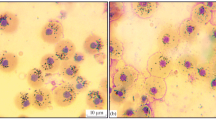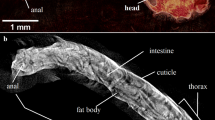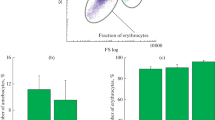Summary
Hydrozoa replace used-up nematocytes (cnidocytes) by proliferation and differentiation from interstitial stem cells (i cells). Repeated pulsed exposure ofHydra to elevated levels of unprotonated ammonia leads to successive loss of the various types of nematocytes: first of the stenoteles, then of the isorhizas and finally of the desmonemes. The loss is due to deficits in supply; the number of nematoblasts and differentiating intermediates is reduced. In the hydroidHydractinia the main process leading to numerical reduction was observed in vivo: mature nematocytes as well as precursors emigrate from their place of origin into the gastrovascular channels where they are removed by phagocytosis. This is a regular means by which these animals down-regulate an induced surplus of nematocytes. With lower effectiveness, pulses of methylamine, trimethylamine and glutamine also induce elimination of the nematocyte lineages. In the long term the population of nerve cells, which are permanently but slowly renewed from interstitial neuroblasts, decreases, too. After 2 months of daily repeated treatment the density of the Arg-Phe-amide-positive nerve cells was reduced to 50% of its normal level. Thus, ammonia induces down-regulation of all interstitial cell lineages. The temporal sequence of the ammonia-induced loss reflects the diverse rates with which the various i cell descendants normally are renewed.
Similar content being viewed by others
References
Ackermann D, Menssen HG (1959) Niedermolekulare, N-haltige Inhaltstoffe der LederkoralleAlcyonium digitatum. Hoppe-Seyler's Z Physiol Chem 317:144–149
Berking S (1988) Ammonia, tetraethylammonium, barium and amiloride induce metamorphosis in the marine hydroidHydractinia. Arch Dev Biol 197:1–9
Berking S, Herrmann K (1990) Dicapryloylglycerol and ammonium ions induce metamorphosis of ascidian larvae. Arch Dev Biol (1990) 198:430–432
Bode HR (1983) Reducing populations of interstitial cells and nematoblasts with hydroxyurea. In: Lenhoff HM (ed) Hydra: research methods. Plenum, New York, pp 291–294
Bode HR, David CH (1978) Regulation of a multipotent stem cell, the interstitial cell of hydra. Prog Biophys Mol Biol 33:189–206
Bode HR, Flick KM, Smith GS (1976) Regulation of interstitial cell differentiation inHydra attenuata: I. Homeostatic control of interstitial cell population size. J Cell Sci 20:29–46
Bode HR, Gee LW, Chow MA (1990) Neuron differentiation in hydra involves dividing intermediates. Dev Biol 139:231–243
Bonner JT, Suthers HB, Odell GM (1986) Ammonia orients cell masses and speeds up aggregating cells of slime moulds. Nature 323:630
Campbell RD (1976) Elimination ofHydra interstitial and nerve cells by means of colchicine. J Cell Sci 21:1–13
Campbell RD, David CN (1974) Cell cycle kinetics and development ofHydra attenuata, II. Interstitial cells. J Cell Sci 16:349–358
David CN (1973) A quantitative method for maceration ofHydra tissue. Roux's Arch Dev Biol 171:259–268
David CN (1980) Control of stem cell proliferation inHydra attenuata. In: Tardent P, Tardent R (eds) Development and cellular biology in coelenterates. Elsevier/North-Holland Biomedical Press, Amsterdam, pp 301–306
David CN (1983) Eliminating interstitial cells with nitrogen mustard. In: Lenhoff HM (ed) Hydra: research methods. Plenum, New York, pp 299–302
David CN, Challoner D (1974) Distribution of interstitial cells and differentiating nematocytes inHydra attenuata. Am Zool 14:537–542
David CN, Gierer A (1974) Cell cycle kinetics and development ofHydra attenuata: III. Nerve and nematocyte differentiation. J Cell Sci 16:359–376
Diehl F, Burnett AL (1964) The role of intertitial cells in the maintainance of hydra: I. Specific destruction of interstitial cells in normal, sexual and non-budding animals. J Exp Zool 155:253–259
Feit IN, Sollitto RB (1987) Ammonia is the gas used for the spacing of fruiting bodies in the cellular slime mold,Dictyostelium discoideum. Differentiation 33:193–196
Fujisawa T (1987a) Inhibition of stenotele differentation by head tissue inHydra. J Cell Sci 87:315–322
Fujisawa T (1987b) An endogenous inhibitor involved in position-dependent stenotele differentation inHydra. Dev Biol 122:210–216
Fujisawa T (1988) Inhibition of stenotele commitment by an endogenous factor inHydra. J Cell Sci 91:361–366
Fujisawa T, David CN (1981) Commitment during nematocyte differentation inHydra. J Cell Sci 48:207–222
Fujisawa T, David CN (1982) Commitment during stenotele differentation inHydra is localized near the S/G2 boundary in terminal cell cycle. Dev Biol 93:226–230
Fujisawa T, David CN (1984) Loss of differentiating nematocytes induced by regeneration and wound healing inHydra. J Cell Sci 68:243–255
Fujisawa T, Nishimiya C, Sugiyama T (1986) Nematocyte differentiation inHydra. Curr Topics Dev Biol 20:pp 281–290
Grimmelikhuijzen CJP (1985) Antisera to the sequence Arg-Pheamide visualise neuronal centralisations in hydroid polyps. Cell Tissue Res 241:171–181
Lange R, Plickert G, Müller WA (1989) Histoincompatibility in a low invertebrate,Hydractinia echinata. Analysis of the mechanism of rejection. J Exp Zool 249:284–292
Lehn H (1951) Teilungsfolgen und Determination von I-Zellen für die Cnidenbildung beiHydra. Z Naturforsch 6:388–391
Madshus IH (1988) Regulation of intracellular pH in eukaryotic cells. Biochem J 250:1–8
Müller WA (1968) Elimination der I-Zellen durch alkylierende Cytostatika und deren Effekte auf die Embryonalentwicklung beiHydractinia echinata. Exp Cell Res 49:448–458
Rauen HM (1964) Biochemisches Taschenbuch; Bd I. Springer, Heidelberg, p 304
Rich F, Tardent P (1969) Untersuchungen zur Nematocyten-Differenzierung beiHydra attenuata Pall. Rev Suisse Zool 76:779–787
Sacks PG, Davis LE (1979) Production of nervelessHydra attenuata by hydroxurea treatments. J Cell Sci 37:189–203
Schindler J, Sussmann M (1977) Ammonia determines the choice of morphogenetic pathways inDictyostelium discoideum. J Mol Biol 116:161–169
Schwoerer-Böhning B, Kroiher M, Müller WA (1990) Signal transmission and covert prepattern in the metamorphosis ofHydractinia echinata (Hydrozoa). Arch Dev Biol 198:245–251
Shiokawa K, Fu Y, Kawazoe Y, Yamana K (1987) Mode of action of ammonia and amine on rRNA synthesis inXenopus laevis embryonic cells. Development 100:513–523
Stanbury JB, Wyngaarden JB, Fredrickson DS, Goldstein JL, Brown MS (eds) (1983) The metabolic basis of inherited disease, 5th edn. Part 3, Disorders of amino acid metabolism. McGraw-Hill, New York
Sternfeld J, David CN (1979) Ammonia plus another factor are necessary for differentiation in submerged clumps ofDictyostelium. J Cell Sci 38:181–191
Sugiyama T, Fujisawa T (1977) Genetic analysis of developmental mechanism in hydra. I. Sexual reproduction ofHydra magnipapillata and isolation of mutants. Dev Growth Differ 19:187–200
Sussmann M, Schindler J (1978) A possible mechanism of morphogenetic regulation inDictyostelium discoideum. Differentiation 10:10–15
Terada H, Sugiyama T, Shigenaka Y (1988) Genetic analysis of developmental mechanisms in hydra: XVIII. Mechanism for elimination of the interstitial cell lineage in the mutant strain Sf-1. Dev Biol 126:263–269
Wang M, Schaap P (1989) Ammonia depletion and DIF trigger stalk cell differentiation in intactDictyostelium discoideum slugs. Development 105:569–574
Welsh JH, Prock PB (1958) Quaternary ammonium bases in coelenterates. Biol Bull (Woods Hole) 115:551–561
Zumstein A (1973) Regulation der Nematocytenproduktion beiHydra attenuata Pall. Roux's Arch Dev Biol 173:294–318
Author information
Authors and Affiliations
Rights and permissions
About this article
Cite this article
Lange, R.G., Holzenburg, P. & Müller, W.A. Pulses of ammonia and methylamine induce down-regulation of nematocyte and nerve cell populations in Hydrozoa (Hydra; Hydractinia). Roux's Arch Dev Biol 199, 123–133 (1990). https://doi.org/10.1007/BF01681485
Received:
Accepted:
Issue Date:
DOI: https://doi.org/10.1007/BF01681485




